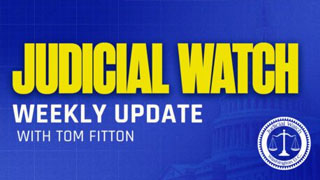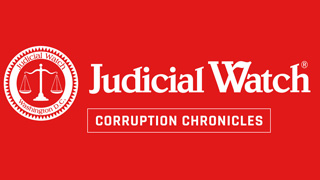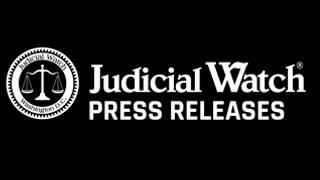

JW Uncovers More Comey Corruption
FBI Documents Detail That Comey Had Trump FBI Docs At His Home!
Judicial Watch Goes To Court on FBI Stonewall and Cover-Up
U.S. Wastes $907 Million Tax Dollars on Useless “Nutrition Education”
FBI Documents Detail That Comey Had Trump FBI Docs At His Home!
As the Justice Department reportedly takes a step to give James Comey a pass for illegal activity, Judicial Watch is uncovering the details of these crimes.
We received six pages of records from the FBI showing that in June 2017, a month after Comey was fired by President Donald Trump, FBI agents visited his home and collected “as evidence” four memos that allegedly detail conversations he had with President Trump. One of his memos was written on June 6, a month after he was fired.
Comey was fired by Trump on May 9, 2017. The memos are dated February 14, 2017; March 30, 2017; and April 11, 2017. Another is dated “last night at 6:30 pm.”
The FBI documents also revealed that Comey recalled writing two other memos after conversations with Trump that he claimed were “missing.” The FBI visit and interview took place on June 7, the day before Comey admitted leaking the memos in testimony to Congress.
The new documents include a June 9 2017 FBI Collected Item Log that states:
On June 7, 2017, at approximately 10:15 A.M., Federal Bureau of Investigation (FBI) Special Agents (SA) [redacted] and [redacted] collected memorandums (memos) as evidence from James Comey at his residence at [redacted]. The memos collected described as follows:
-
- One memo dated February 4, 2017, two pages;
- One memo dated March 30, 2017, two pages;
- One memo dated April 11, 2017, one page;
- One memo dated “last night at 6:30 pm,” four pages
We also received a newly declassified FBI document dated June 16, 2017 in which FBI agents describe Comey telling them that he had written two additional Trump meeting memos that he could no longer find:
Former FBI Director James Comey was interviewed at his residence at [redacted]. This interview was scheduled in advance, for the purpose of providing certain classified memoranda (memos) to Comey for review. After being advised of the identity of the interviewing Agents and the nature of the interview, Comey provided the following information:
After reviewing the memos, Comey spontaneously stated, to the best of his recollection, two were missing:
In the first occurrence, Comey said at an unknown date and time, between January 7, 2017, which Comey believed was the date of his briefing at Trump Tower, and Trump’s inauguration on January 20th, 2017, Comey received a phone call from President Elect Donald J. Trump. The originating telephone number may have had a New York area code. Following the telephone conversation, Comey drafted and e-mailed a memo to James Rybicki and FBI Deputy Director Andrew McCabe.
In the second instance, Comey was on his way to a FBI leadership conference in Leesburg, Virginia (March 9, 2017) when he was diverted to Liberty Crossing to respond to a request from Trump to contact him. Comey contacted Trump from Liberty Crossing on a Top Secret telephone line. The conversation was “all business” and related to [redacted]. Comey is less sure he drafted a memo for his conversation but if he did, he may have sent it on the FBI’s Top Secret network.
We obtained the records in a Freedom of Information Act (FOIA) lawsuit against the Justice Department that sought all records of communications relating to Comey’s providing memoranda of his conversations with President Trump to Special Counsel Robert Mueller and his team. (Judicial Watch v. U.S. Department of Justice (No. 1:18-cv-00932)).
These extraordinary FBI docs further confirm that James Comey should never have had FBI files on President Trump at his home and that the FBI failed to secure and protect these private and classified files. Comey’s illegal leaking these FBI files as part of his vendetta against President Trump (directly resulting in the corrupt appointment of Robert Mueller) ought to be the subject of a criminal investigation. I know there are reports that Attorney General Barr declined to pursue an extraordinary criminal referral from the Inspector General of the Justice Department on this very issue. General Barr should reconsider.
On June 8, 2017, Comey testified to the Senate Intelligence Committee that he leaked memos of his conversations with President Trump “because (he) thought that might prompt the appointment of a special counsel.” Columbia University Law professor Daniel Richman, a friend of Comey’s, reportedly “turned over copies of the former FBI director’s explosive memos … to the FBI, sidestepping a request by congressional committees to deliver the materials to Capitol Hill.”
The Justice Department previously argued to the court in a separate case that Comey’s leak of the memo regarding former National Security Advisor Michael Flynn was unauthorized and compared it to WikiLeaks. Comey admitted to Congress regarding the “Flynn” memo, “I asked a friend of mine to share the content of the memo with a reporter [for The New York Times] … I asked him to because I thought that might prompt the appointment of a special counsel.” The New York Times published a report about the memo on May 16, 2017. Special Counsel Robert Mueller was appointed the following day.
The Hill noted in a July 9, 2017 report that, “More than half of the memos former FBI Director James Comey wrote as personal recollections of his conversations with President Trump about the Russia investigation have been determined to contain classified information, according to interviews with officials familiar with the documents.”
The issue over whether to prosecute aside, Judicial Watch will continue to pursue the truth and accountability for the corrupt Comey.
Judicial Watch Goes To Court on FBI Stonewall and Cover-Up
We were in the courtroom of U.S. District Court Judge Reggie B. Walton this week for a hearing regarding the rate of production of emails, text messages, and other communications between former FBI official Peter Strzok and former FBI attorney Lisa Page (Judicial Watch v. U.S. Department of Justice (No. 1:18-cv-00154)).
“Upon further consideration,” Judge Walton had written, “the Court is concerned that the processing rate adopted by the Court may be inadequate.” The Court’s July 24 order follows a joint status report by the FBI and us disclosing that only 6,000 of almost 20,000 responsive records have been processed since May 2018.
The hearing came in our January 2018 Freedom of Information Act (FOIA) lawsuit for all communications between Strzok and Page (Judicial Watch v. U.S. Department of Justice (No. 1:18-cv-00154)).
As you know, Strzok and Page were key investigators in the Clinton email and Russia collusion investigations. Strzok was removed from the Mueller investigative team in July 2017 and reassigned to a human resources position after it was discovered that he and Page, who worked for FBI Deputy Director Andrew McCabe, and with whom Strzok was carrying on an extramarital affair, exchanged pro-Clinton and anti-Trump text messages.
Page resigned in May 2018. Strzok was dismissed from the FBI in August 2018.
The FBI has been slow rolling the release of Page-Strzok communications and is still hiding all their infamous text messages. We hope the Court recognizes the pubic interest in ensuring the FBI quickly releases key documents about the biggest scandal in American history – the Spygate abuses targeting President Trump.
Here’s the background.
On May 21, 2018, Judge Walton ordered the FBI to begin processing thousands of pages of previously undisclosed records between FBI officials Strzok and Page.
In June, we uncovered documents in this case including emails showing the FBI’s attempts to muddle former FBI Director James Comey’s testimony on the Hillary Clinton email investigation and collusion between the FBI and the media.
Other documents revealed then-FBI General Counsel James Baker instructing FBI officials to expedite the release of FBI investigative material to Hillary Clinton’s lawyer, David Kendall in August 2016. Kendall and the FBI’s top lawyer discussed quickly obtaining Clinton’s “302” report of the FBI/DOJ interview.
In February, we uncovered documents showing an evident cover-up of a chart of potential violations of law by former Secretary of State Hillary Clinton. Also, we received documents exposing that Baker discussed the investigation of Clinton-related emails on Anthony Weiner’s laptop with Clinton’s lawyer, David Kendall. Baker then forwarded the conversation to his FBI colleagues.
In September 2018, we uncovered documents showing email exchanges between fired FBI official Peter Strzok and FBI attorney Lisa Page revealing that FBI officials used unsecure devices in discussing how the U.S. could improve the sharing of sensitive data with the European Union top executive governing commission. The documents also reveal that high-ranking FBI officials were not properly read-in to top-secret programs.
And in July 2018, we received documents from the Department of Justice revealing former top FBI official Peter Strzok and FBI attorney Lisa Page’s profanity-laced disdain for FBI hierarchy and policies.
You can see why the FBI wants to take as long as two years to release the Strzok-Page materials. The Court, at the conclusion of the hearing this week, ordered Judicial Watch and the Justice Department to work together to help ensure that we can get key documents in a more timely way.
I will keep updated as events develop.
U.S. Wastes $907 Million Tax Dollars on Useless “Nutrition Education”
Waste, fraud and abuse is the operation motto for many government programs. Our Corruption Chronicles blog has the details on more extraordinary waste of your tax dollars:
Besides spending tens of billions of dollars on fraud-infested programs to feed the poor, the U.S. government wastes an additional $907 million to give recipients useless “nutrition education” courses with rates of effectiveness that cannot be assessed. It marks the latest scandal to rock the government’s famously bloated and corrupt food stamp program as well as a multi-billion-dollar sister project that feeds millions of low-income women and their children.
The U.S. Department of Agriculture (USDA) operates and funds both programs and spends a fortune on them annually. The grand master is food stamps, renamed Supplemental Nutrition Assistance Program (SNAP) by the Obama administration to eliminate the welfare stigma. Under Obama the food stamp tab reached a ghastly $80.4 billion in one year to provide a record 46 million people with the welfare benefit. The Trump administration has reduced it a bit, but not by much. The latest USDA figures reveal the food stamp budget is hovering north of $60 billion annually to feed around 44 million people. That’s still a chunk of change. Uncle Sam spends $5.3 billion a year on the other program, which is known as Women Infants and Children (WIC). It serves around 7 million recipients and claims to “safeguard the health of low-income women, infants, and children younger than 5 who are at nutritional risk.”
Besides doling out huge sums of taxpayer dollars to feed this large demographic, the USDA dedicates extra money to school the beneficiaries about nutritional matters. The classes and counseling are conducted in daycares, grocery stores, public housing, health clinics, food banks, recreation centers and other public facilities throughout the country.
In fiscal year 2017 this cost $907 million, according to a federal audit that concludes the effectiveness of the so-called “SNAPEd” cannot be aggregated or reviewed. States, which are responsible for distributing food stamps, also provide information about the educational programs in a way that “hinders the USDA’s ability to assess the effectiveness” and “determine whether SNAPEd is achieving its goals,” according to the audit, which was conducted by the investigative arm of Congress, the Government Accountability Office (GAO). That’s diplomatic, sugar coating for it’s a waste. The congressional watchdog further reveals that it already reviewed the USDA’s dubious nutrition education efforts a decade and a half ago and found “challenges” across the agency.
The GAO report breaks down the expenses and offers some details about the actual courses. The USDA spent $422 million to educate WIC recipients about good nutrition and $404 million to school those who get food stamps. An additional $51 million went to an “expanded food and nutrition education program,” $16 million to “team nutrition” and $13 million to a “food insecurity nutrition incentive grant program.” Those wondering how it all works may find answers in this line from the GAO: “Sometimes multiple nutrition education programs operate in the same setting. For example, SNAP-Ed may provide classes for students while Team Nutrition may distribute teacher training materials and nutrition education curricula to the same school.” The bottom line is that most of the USDA’s nutrition education programs target interventions to low income populations, according to the audit.
Why does the USDA waste such large sums on this nonsense? Because another government agency, the Centers for Disease Control and Prevention (CDC), claims that the diet of many Americans lacks adequate sources of good nutrition and that contributes to costly chronic health conditions. In typical government fashion, the solution is to throw money at the so-called problem with no follow through. The goal, according to the USDA, is to help educate Americans on nutrition and improve their dietary choices. The agency considers it an important intervention that also involves social marketing as well as policy and environmental changes. More than 4 million people participated in the “direct education interventions” last year, yet it remains unclear what impact the costly sessions had.
Fraud and waste have been pervasive in the government’s food stamp program for years and Judicial Watch has reported on it extensively. The Obama administration left the program in disarray, but the problems have continued in the Trump administration. Just last year authorities in north Florida arrested nearly 200 people for operating a sophisticated ring in which millions of dollars in food stamps were fraudulently exchanged for cash and drugs. More than 22,000 fraudulent transactions totaling $3.7 million were documented by a task force of local and federal authorities.
Until next week,















